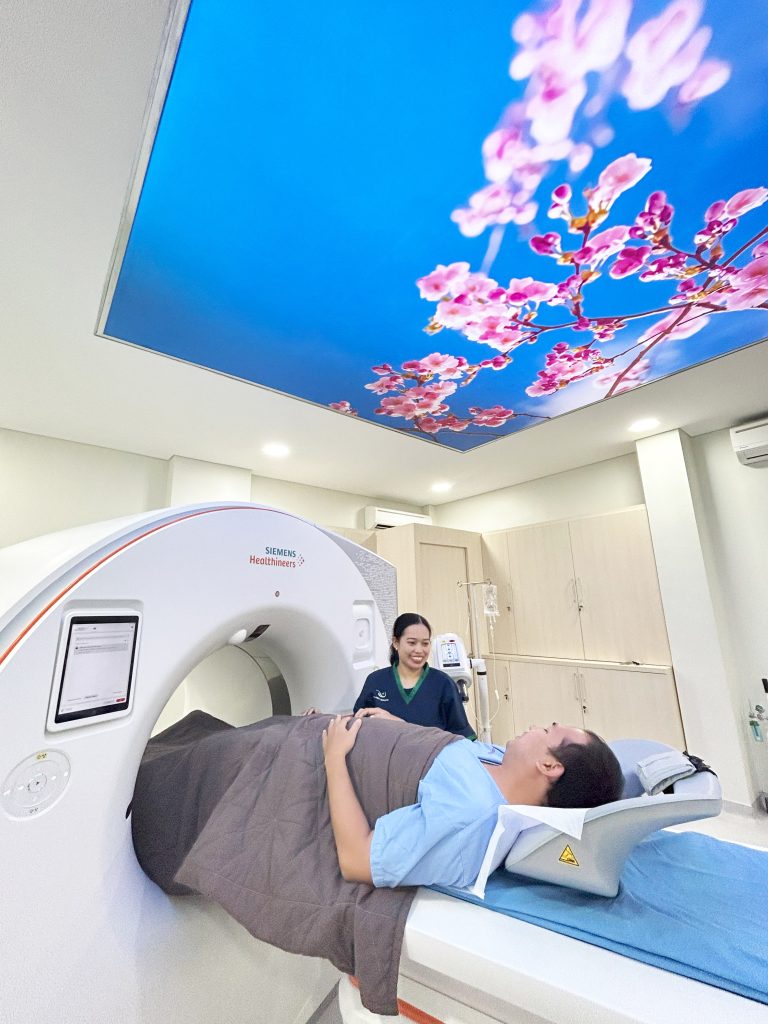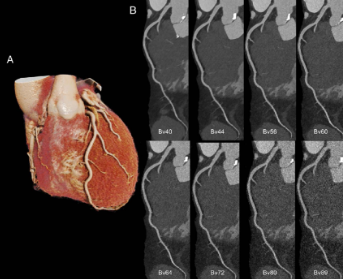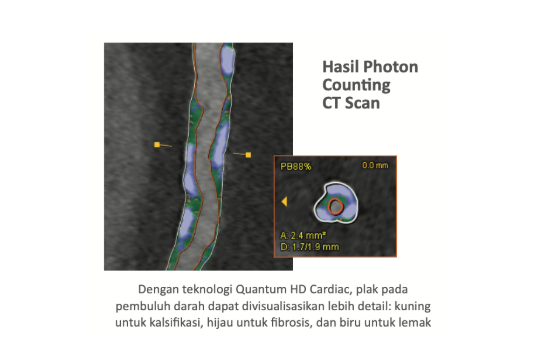By: Geraldus Sigap

Cardiac CT has been used for years to detect coronary artery disease, assess calcium deposits, and evaluate the structure of the heart. However, traditional CT scans often produce images that require specialized interpretation, sometimes making it difficult to visualize fine details. Cinematic imaging technology enhances the clarity of these scans, creating lifelike, photorealistic images that allow doctors to see the heart with unprecedented detail. This advancement helps detect blockages, plaque formations, and other abnormalities with greater accuracy, leading to better diagnosis and treatment plans.

Figure 1. Results from cardiac CT
How Cinematic Imaging Improves Cardiac CT
Traditional CT scans use X-ray technology to capture cross-sectional images of the heart and blood vessels. These images are then processed to create a detailed view of the cardiovascular system. While effective, standard CT images may lack depth and realistic contrast, making it challenging to differentiate between normal and diseased tissue.
Cinematic Cardiac CT enhances these images by using advanced rendering techniques that simulate how light interacts with tissues in the body. This creates a more realistic, three-dimensional view of the heart, similar to what a surgeon would see during an operation. The increased contrast and clarity allow doctors to identify early-stage plaque buildup, arterial narrowing, and subtle heart abnormalities that might go unnoticed with traditional imaging methods.
By providing highly detailed images, cinematic imaging helps doctors assess the composition of plaques in the coronary arteries. Some plaques are soft and more likely to rupture, leading to heart attacks, while others are calcified and stable. Understanding the nature of these plaques allows cardiologists to determine the risk of future cardiovascular events and recommend the most appropriate treatment.
Detecting Hidden Heart Disease Before Symptoms Appear
One of the greatest challenges in cardiology is identifying heart disease before it causes symptoms. Many people with coronary artery disease (CAD) do not experience noticeable warning signs until a heart attack or angina occurs. This is why early screening is crucial, especially for individuals at high risk due to factors such as high cholesterol, hypertension, diabetes, smoking, or a family history of heart disease.
Cinematic Cardiac CT provides a clear visualization of the coronary arteries, allowing doctors to detect blockages and narrowing of blood vessels at an early stage. This makes it possible to intervene with lifestyle changes, medications, or procedures before a serious cardiac event occurs. Unlike traditional stress tests, which may not always detect small blockages, Cinematic Cardiac CT offers a direct and precise assessment of arterial health.
Patients experiencing chest pain or shortness of breath can also benefit from this advanced imaging technique. Instead of undergoing invasive procedures like cardiac catheterization, a non-invasive Cinematic Cardiac CT scan can provide a detailed diagnosis, allowing doctors to determine whether further intervention is necessary.
Understanding the Role of Plaques in Heart Disease
Plaque buildup in the arteries is one of the leading causes of heart attacks and strokes. These plaques consist of cholesterol, calcium, and other substances that accumulate over time. If a plaque ruptures, it can form a clot that blocks blood flow to the heart or brain, leading to a life-threatening emergency.
With traditional imaging techniques, distinguishing between soft, high-risk plaques and stable, calcified plaques can be challenging. Cinematic Cardiac CT enhances visualization by highlighting different textures and densities within the arteries. This allows doctors to assess whether a patient is at risk for a sudden cardiac event and take preventive measures accordingly.
Who Should Consider a Cinematic Cardiac CT Scan?
Not everyone needs a cardiac CT scan, but certain individuals may benefit significantly from early screening. Some key candidates for Cinematic Cardiac CT include:
- Individuals with a family history of heart disease
- Patients with high cholesterol, high blood pressure, or diabetes
- Smokers or those with a history of heavy alcohol consumption
- People who are overweight or lead a sedentary lifestyle
- Patients experiencing chest pain, fatigue, or shortness of breath
- Those with an abnormal heart stress test who need further evaluation
For high-risk individuals, Cinematic Cardiac CT can provide a clearer picture of heart health, allowing doctors to recommend preventive measures such as medications, dietary changes, or interventional procedures like angioplasty before serious complications arise.

Figure 2. Results from the Photon Counting CT Scan
One of the most significant advancements in Cinematic Cardiac CT is its ability to accurately differentiate plaque types within the coronary arteries. Traditional CT scans often struggle with the blooming effect, which can overestimate the severity of arterial blockages due to calcium deposits. With Quantum HD Cardiac imaging, doctors can now clearly distinguish between stable calcified plaques, fibrotic plaques, and lipid-rich plaques, the latter being more prone to rupture and cause heart attacks. This high level of detail allows cardiologists to assess the true risk of cardiovascular events and make more precise treatment decisions.
Additionally, stent evaluation has greatly improved with this technology. Conventional CT scans often suffer from metal artifacts, making it difficult to determine if a stent is still open or has become blocked (in-stent restenosis). Cinematic Cardiac CT minimizes these distortions, offering a clearer view of blood flow within the stent. This enables non-invasive monitoring of patients with previous coronary interventions, reducing the need for unnecessary catheterization procedures. Combined with lower radiation exposure and ultra-high resolution, this innovation is transforming how heart disease is diagnosed and managed, ensuring earlier detection and better treatment outcomes.
A Non-Invasive and Safe Approach to Heart Imaging
Many heart diagnostic procedures, such as cardiac catheterization, require inserting a tube into the arteries to examine blood flow and detect blockages. While effective, these procedures carry risks of complications such as bleeding and infection.
Cinematic Cardiac CT is a non-invasive alternative that requires no hospital stay or recovery time. The scan typically takes only a few minutes, and patients can resume normal activities immediately after the procedure. Unlike traditional angiograms, which require inserting a catheter into the heart, Cinematic Cardiac CT simply involves lying still while an imaging machine captures high-resolution scans.
The procedure is also safe for most patients, as it uses low-dose radiation to create detailed images. Advances in imaging technology have significantly reduced radiation exposure, making it an appropriate choice for many individuals, including those who require regular monitoring of heart conditions.
A New Era in Heart Disease Diagnosis
Cinematic Cardiac CT represents a major advancement in heart disease detection, offering clearer, more detailed imaging that allows doctors to identify and manage cardiovascular risks before they become life-threatening. By providing non-invasive, high-resolution visuals of the heart and arteries, this revolutionary technology is transforming the way heart disease is diagnosed and treated.
For those at risk of heart disease, undergoing Cinematic Cardiac CT can be a life-saving step, offering insights that were previously difficult to obtain. With early detection and expert medical care available at RS Abdi Waluyo, patients can take proactive measures to protect their heart health and lead a longer, healthier life.
Resources
- Mergen V, Sartoretti T, Baer-Beck M, et al. Ultra-High-Resolution Coronary CT Angiography With Photon-Counting Detector CT: Feasibility and Image Characterization. Invest Radiol 2022;57(12):780–788.
- Multimodality cardiac imaging in the 21st century: evolution, advances and future opportunities for innovation – PMC [Homepage on the Internet]. [cited 2025 Feb 11];Available from: https://pmc.ncbi.nlm.nih.gov/articles/PMC7774683/
- Rowe SP, Johnson PT, Fishman EK. Initial experience with cinematic rendering for chest cardiovascular imaging. Br J Radiol 2018;91(1082):20170558.
- Rowe SP, Chu LC, Recht HS, Lin CT, Fishman EK. Black-blood cinematic rendering: A new method for cardiac CT intraluminal visualization. J Cardiovasc Comput Tomogr 2020;14(3):272–274.
